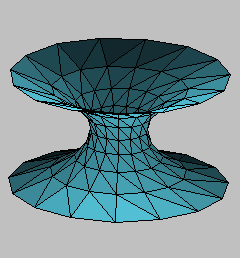

 |
This catenoid is a complete discrete minimal surface given by explicit formulas for its vertices.
The authors have found an explicit representation of a 4-parameter family of complete discrete catenoids. These catenoids are the first explicitly known discrete versions of a complete minimal surface beside the trivial plane which are solutions of the variational problem for the discrete surface area. This explicit representation allows to generate exact discrete minimal surfaces without numerical errors which is useful, for example, in index computations.
A discrete surface in Euclidean space is mesh T of planar triangles with the combinatorics of a 2-dimensional simplicial complex consisting of triangles. The shape of a discrete surface is uniquely determined by the position of the vertices. The area of a discrete surface is the sum of the Euclidean areas of the triangles in T. Variations in the set of discrete surfaces are defined by C2 variations of the vertices preserving the combinatorics of the mesh and the flatness of the triangles. A discrete surface is minimal if it is critical for the discrete area functional with respect to all boundary-preserving variations.
The catenoids of the 4-parameter family are embedded and complete discrete minimal catenoids with dihedral rotational symmetry and planar meridians. We will use the following four parameters to describe the family:
We choose the z-axis as the dihedral symmetry axis and a meridian in the xz-plane,. Then the catenoid is completely described by the following four properties:
1. The dihedral angle is 2Pi/k.
2. The vertices of the meridian in the xz-plane interpolate the smooth hyperbolic cosine curve
x(z) = r Cosh(az/r)
with a = (r/delta) ArcCosh(1 + r-2 delta2 (1 + Cos(2Pi/k))-1),
where r is the waist radius of the interpolated hyperbolic cosine curve, and delta is the constant vertical distance between adjacent vertices of the meridian.
3. For any given arbitrary initial value z0, the profile curve has vertices of the form (xj,0,zj) with zj = z0 + j delta and xj = x(zj), where x(z) is the meridian in item 2 above.
4. The planar trapezoids of the catenoid may be triangulated independently of each other, that is, one can choose either of the two choices for the diagonal edge across each planar trapezoid.
This explicit description of discrete catenoids is proven in the work [1] of the authors referenced below.
Although discrete minimal surfaces are critical for area, they are not necessarily area minimizing. The discrete catenoid shown here from the 4-parameter family is an unstable critical point of the discrete area functional.
Model produced with: JavaView 1.90, see http://www.javaview.de/
| Keywords | Catenoid; Minimal Surface; Unstable Catenoid; Stability; Discrete Surface | |
| MSC-2000 Classification | 53-04 (53-XX, 68Uxx, 68Rxx, 65Kxx, 65M50) | |
| Zentralblatt No. | 01683028 |
Submitted: Mon May 1 09:32:05 CET 2000.
Accepted: Mon Nov 20 17:06:57 CET 2000.
Technische Universität BerlinWayne Rossman
Fachbereich Mathematik
Straße des 17. Juni 136
10623 Berlin
Germany
polthier@math.tu-berlin.de
http://www-sfb288.math.tu-berlin.de/~konrad
Kobe University
Mathematics Department
Faculty of Science
Rokko, Kobe 657-8501
Japan
wayne@math.sci.kobe-u.ac.jp
http://www.math.kobe-u.ac.jp/HOME/wayne/wayne.html